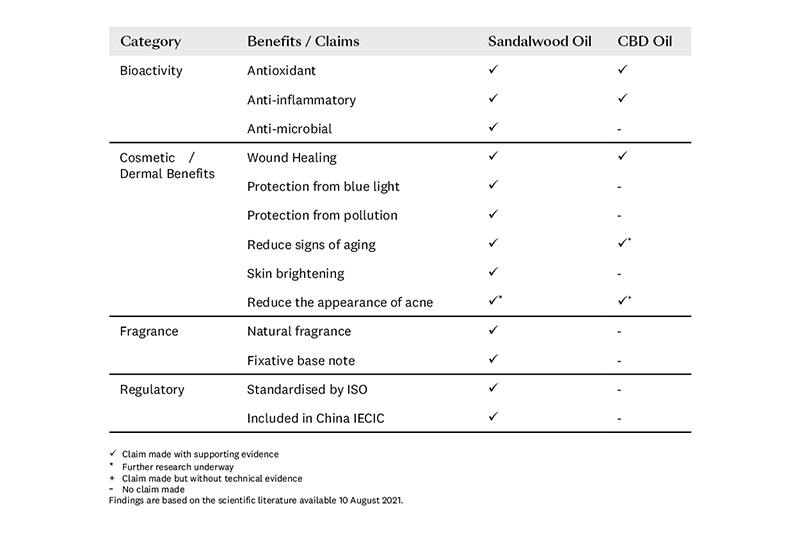With cannabidiol (CBD oil) recently banned from being used in cosmetics in China, and other markets restricting the use of the oil, like the United Kingdom and Australia, cosmetics formulators are being encouraged to consider Indian sandalwood oil as an effective alternative to CBD oil following a new scientific review revealing Indian sandalwood oil has more substantiated benefits.
Indian sandalwood oil (Santalum album) is considered the most luxurious of all sandalwood oils and is obtained through steam distillation of the tree’s aromatic heartwood. It has been used for centuries in cosmetics, such as Ayurvedic skin care – topical treatments based on principles of a 5000-year-old Indian health system – with sandalwood listed in the Charaka Samhita, an Ayurvedic Sanskrit text, over 2,000 years ago.
Today, Indian sandalwood oil is fast becoming a new trend ingredient in a myriad of beauty and personal care applications. A vast sustainable supply is now available in Australia through companies like Quintis Sandalwood with more research being conducted to prove its efficacy.
To showcase the power of Indian sandalwood oil as an alternative for CBD oil in cosmetics, Quintis Sandalwood recently conducted a review of existing scientific studies to assess the benefits of each.
The findings revealed that Indian sandalwood oil has more scientifically proven benefits compared to CBD oil making it a good alternate in cosmetic applications, especially in skin care.
Dr Dhanushka Hettiarachchi, Ph.D., Product Manager for Quintis Sandalwood, said Indian sandalwood oil is a real game changer for cosmetics.
“While CBD oil appears to be a popular choice with some scientific literature available, the majority of the current CBD skin activity claims are based on anecdotal evidence; more research is required to truly prove its efficacy and potency.
"Indian sandalwood oil is a great natural multipurpose ingredient for cosmetics care and an alternative for CBD oil as it is an effective protective and anti-ageing active ingredient, and it has scientifically proven bioactivity and dermal benefits for the skin including assisting with evening skin tone and wound healing,” says Dr Hettiarachchi.
“Indian sandalwood oil can be included in products like face washes, moisturisers and serums at different concentrations for deep penetrating action and body care products like natural deodorant. Other products sandalwood oil can be utilised in is water-based facial sprays, washes and hydrogels that can be prepared by emulsifying the oil for its aroma and antioxidant skin benefits.”
The scientific review found Indian sandalwood oil is similar or has more efficacy than CBD oil across the following five key benefits and claims which are important for skin care formulations:
- Wound healing - Both CBD oil and Indian Sandalwood Oil act on keratinocyte proliferation to facilitate wound healing. Both do this by stimulating the calcium channels on keratinocytes, however, Indian sandalwood oil acts specifically on the receptor OR2AT4[4], while CBD oil acts specifically on CBD CB-1 receptor[6].
- Skin Brightening - Studies have shown that Indian sandalwood oil inhibits the tyrosinase enzyme, the key enzyme in producing melanin, which is responsible for uneven skin tone, dark spots, and pigmentation[5]. To date, there is no research to suggest that CBD can inhibit the tyrosinase enzyme or reduce the skins melanin production, with CBD’s brightening claims all stemming from its antioxidant properties.
- Antioxidant – According to a study recently published in the Cosmetics Journal, commissioned by Quintis Sandalwood, Indian sandalwood oil is a potent antioxidant that works on the Keratinocytes to protect the skin from reactive oxygen species (ROS) generated by exposure to environmental stressors such as blue light and pollution. ROS are free radicals that cause damage to cell structure, breaking down collagen, reducing elasticity and causing an un-even skin tone [1]. CBD oil has similar antioxidant properties to ISO, working on the Keratinocytes to protect the skin from reactive oxygen species (ROS) [6,7].
- Anti-Inflammatory - Indian sandalwood oil is widely known for its ability to inhibit the production of cytokines/chemokines (IL, TNF-a) and prostaglandins, all of which cause inflammation in the skin ultimately resulting in pigmentation and collagen degradation. It also up-regulates 11βHSD1 enzyme to covert inflammatory cortisone to inactive cortisol [2,3,4]. CBD stimulates the CB-2 receptors in skin to reduce cytokine chemokine, however, the mechanism remains ambiguous [6,7].
- Anti-ageing - Indian sandalwood oil is found to inhibit the MMP1 enzyme generated in the skin when a person is exposed to certain internal (lifestyle) and environmental stressors. The MMP1 enzyme is responsible for breaking down collagen[1]. A reduction in collagen can result in increased fine lines/wrinkles and reduces skin elasticity and thickness. To date, there is no research to suggest that CBD can inhibit the MMP1 enzyme, with CBD’s anti-aging claims all stemming from its antioxidant properties[6].
“Our Indian sandalwood oil has over 20 international certifications including being approved on the Chinese Inventory of Existing Cosmetics Ingredients, it is listed as a safe ingredient with the US Food & Drug Administration (FDA), and meeting the standards of the British Pharmacopoeia, so there is great opportunity for this precious, medicinal ingredient to be considered a high-quality replacement for CBD oil.
From its skin benefits such as anti-tyrosinase and antimicrobial activities, through to its calming properties, Indian sandalwood oil is the perfect ingredient for holistic cosmetics applications,” says Dr Hettiarachchi. Indian sandalwood oil samples can be requested through the Quintis Sandalwood website.

References:
1. Francois-Newton, V., et al. (2021). "Antioxidant and Anti-Aging Potential of Indian Sandalwood Oil against Environmental Stressors In
Vitro and Ex Vivo." Cosmetics 8(2): 53.
2. Sharma, M., et al. (2018). "East Indian sandalwood oil is a phosphodiesterase inhibitor: A new therapeutic option in the treatment of
inflammatory skin disease." Frontiers in Pharmacology 9: 200.
3. Sharma, M., et al. (2014). "Suppression of Lipopolysaccharide‐stimulated Cytokine/Chemokine Production in Skin Cells by
Sandalwood Oils and Purified α‐santalol and β‐santalol." Phytotherapy research 28(6): 925-932.
4. Moy, R. L. and C. Levenson (2017). "Sandalwood album oil as a botanical therapeutic in dermatology." The Journal of clinical and
aesthetic dermatology 10(10): 34.
5. Misra, B. B. and S. Dey (2013). "TLC-bioautographic evaluation of in vitro anti-tyrosinase and anti-cholinesterase potentials of
sandalwood oil." Natural Product Communications 8(2): 1934578X1300800231.
6. Baswan, S.M., Klosner, A.E., Glynn, K., Rajgopal, A., Malik, K., Yim, S. and Stern, N. (2020). “Therapeutic potential of Cannabidiol
(CBD) for skin health and disorders. Clinical, cosmetic and investigational dermatology, 13, 927.
7. Liu, C., Li, H., Xu, F., Jiang, X., Ma, H. and Seeram, N.P. (2021). “Cannabidiol Protects Human Skin Keratinocytes from Hydrogen-
Peroxide-Induced Oxidative Stress via Modulation of the Caspase-1–IL-1β Axis”. Journal of Natural Products, 84(5), 1563.




